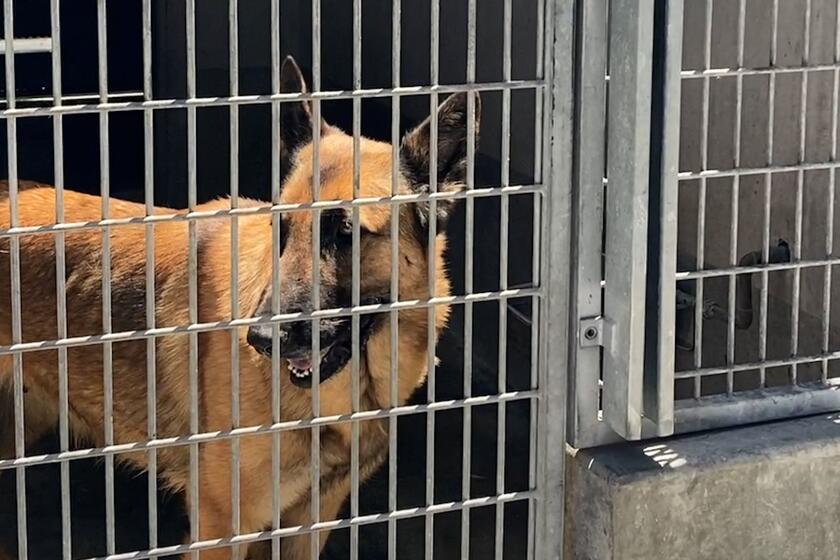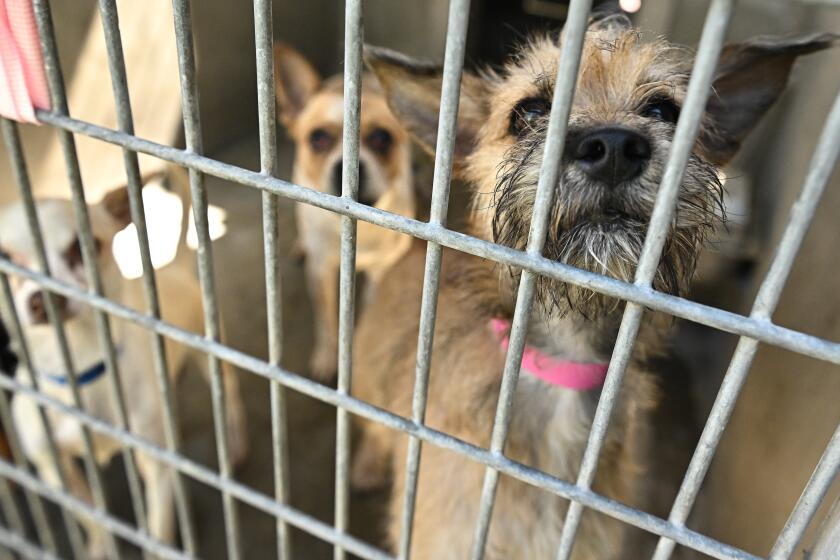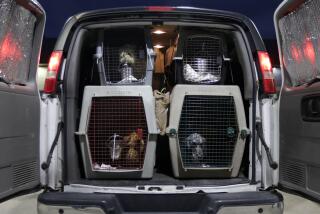Mayor Bass said she’d save L.A.’s shelter animals. More dogs and cats are dying

Jake, a tawny 2-year-old mutt in L.A.’s West Valley shelter, wasn’t doing well.
After six months at the shelter, he was running back and forth and jumping in his kennel.
So shelter workers put him on the euthanasia list in September.
“With the current staff we are unable to fulfill his enrichment needs and it is inhumane to continue housing in a shelter environment,” the workers’ notes said.
The number of dogs euthanized in animal shelters run by the city of L.A. has skyrocketed this year.
From January to September, 1,224 dogs were euthanized at the city’s six shelters — a 72% increase compared with the same period a year ago, according to a Times analysis.
The number of dogs entering the shelters has increased each year since 2022. But the number put to death this year has far outpaced the population gain. The euthanasia rate for dogs increased from 5.5% last year to more than 8% this year during the January-to-September period.
About 1,517 cats were euthanized through September— a 17% increase from a year ago.
In overcrowded shelters where dogs can go weeks without a walk and may live in feces-covered kennels, some animals start behaving poorly and suffer “mental and emotional breakdown,” according to a report by Best Friends Animal Society, a rescue group that has long worked with the city shelters.
That makes them less likely to be adopted — and more likely to be euthanized.
The city’s euthanasia list, available on its website, shows that Jake and some other dogs are being sentenced to death not because they are seriously ill or arrive with severe behavioral issues but because the chronically understaffed and underfunded shelters cannot meet their basic needs.
Agnes Sibal, a spokesperson for LA Animal Services, the city department that runs the shelters, pointed to an “overcrowding crisis” with “nowhere to house incoming dogs.”
“This means that dogs with behavioral challenges are more likely to become at risk of euthanasia,” Sibal said.
After Mayor Karen Bass took office in December 2022, she vowed to save animals’ lives and make L.A. “a national model for animal welfare.”
She boosted the Animal Services budget by 18% — much lower than the 56% increase sought by the department — then trimmed the budget slightly the following fiscal year. She also hired a new general manager, Staycee Dains, who had run Long Beach’s shelters.
L.A.’s animal services agency is understaffed and relies on volunteers. At one overcrowded shelter, dogs sit in kennels for weeks or months without being walked.
In September, Best Friends announced it was withdrawing an offer of financial support to the city, stating that it would take several million dollars in funding to other shelters that “demonstrate a greater sense of urgency and commitment to save at-risk pets.”
“The current administration squandered the advantages it had inherited and did not invest in capacity building, foster programs, animal wellbeing, public and staff safety and customer service,” Best Friends said in a statement.
Gabby Maarse, a spokesperson for Bass, said in an email that “as a result of urgent work,” about 25,000 animals were adopted or rescued from the shelters — a 17% increase from the same period last year.
The city has made investments to “expand the roaming cat spay/neuter program, increase overall spay/neuter, hire critical staff members, make improvements and repairs at the six shelters, and deal with critical safety issues,” Maarse said.
Despite the higher euthanasia rates, most animals still leave the city shelters alive, whether they are adopted, taken in by rescue groups or claimed by their original owners. The “save rate” was 91% for dogs and 81% for cats this year through September.
Shelters across the country are dealing with an influx of animals, as high rents and the rising cost of veterinary care lead people to give up their pets.
From January to September of this year, 33,028 dogs, cats and kittens entered L.A. city shelters — an 11% rise over the same period last year. Dogs made up nearly half that number.
Still, the L.A. shelters were even more crowded pre-pandemic. During the first nine months of 2019, more dogs and cats entered city shelters than in the same period in 2024, the Times analysis showed. Yet euthanasia rates were lower for both dogs and cats in 2019 than this year.
Sibal, the Animal Services spokesperson, said that more large dogs are coming into the shelters than in previous years and they are staying for longer periods. Larger dogs can take up to twice as long to get adopted, exacerbating overcrowding and leading to more euthanasias, she said.

Because of the lack of space, some dogs have been living in crates in hallways and staff rooms, Sibal said.
Earlier this year at the city’s West L.A. shelter, two puppies were housed in the room where animals are put to death. Sibal called the situation unusual and said the intent was to protect the puppies from contracting diseases.
In June, shelter volunteers emailed Bass’ office to question the city’s euthanasia policies.
Dogs that had been labeled adoptable to the public were now being marked for euthanasia, the email said. And some dogs that had been described as friendly were re-categorized as available to rescue groups, but not the general public, because they were now deemed to have behavioral issues.
“The result is a conveyor belt pace of killing happy, healthy dogs falsely labeled as unadoptable,” the email said.
Asked if the city’s euthanasia policies had changed, Sibal wrote that the agency is seeking to ensure “public safety and humane animal care.”
“We must also do this while balancing overcrowding and fulfilling community needs,” Sibal said. “Our commitment to lifesaving has not wavered.”
Jill Dyché, executive director of the rescue group Outta the Cage, regularly visits the city’s shelters. Some dogs that have fought with other dogs are isolated and then listed for euthanasia, while others are not, she said.
“The euthanasia policies are still very fuzzy,” she said. “It seems to be a moving target.”
In a 16-page report documenting conditions in the East Valley and Chesterfield Square shelters this summer, Best Friends criticized Dains, the Animal Services general manager, as the “biggest barrier” to improving conditions at the shelters.
The shelters lacked written protocols, and the staff reported that the euthanasia policy “changed five times in the last year” without communication about the changes.
The report also detailed ways to reduce the number of dogs in city shelters. The solutions ranged from helping owners keep their pets to better customer service for potential adopters to letting adopters take dogs home before returning for spay or neuter operations.
The report described lengthy stays for dogs at the Chesterfield Square shelter, with little human interaction and possibly “two weeks or more before they get any extended time outside of their kennels.”

One dog named Olive Oil left her kennel only 14 times during a 240-day stay and was on the euthanasia list before being rescued, the report said.
The report also noted that “solid organic matter” is sometimes not removed from kennels and that some kennels were not cleaned beyond spraying them with water, with the dogs still inside.
At the East Valley facility, a worker “continuously” sprayed a brown female dog in the face while cleaning her kennel.
“Attempting to run to the back of the kennel, the dog fell repeatedly,” the report said.
City officials declined to comment on the Best Friends report, and Dains declined to talk to The Times. Dains, who earns about $272,730 annually, went on paid leave earlier this year and hasn’t returned.
City Controller Kenneth Mejia, who volunteers at the shelters, has used social media to highlight the higher euthanasia numbers and criticize city budget decisions.
A large portion of the city’s $5.9-billion operating budget goes to the Police Department, which received $1.9 billion this fiscal year. Animal Services received about $30 million.
L.A. City Council members on Monday sought answers about the state of Animal Services during the city’s budget discussions.
Mejia told The Times that “everyone at City Hall” knows about the understaffing and crowding issues at the animal shelters, yet Bass and most of the City Council backed budget cuts for the department this year.
“The city needs to do more to protect the animals, department staff and the public — not just let the animals suffer deteriorating health in our shelters and end up getting euthanized,” Mejia said.
Animal welfare consultant Kristen Hassen, whose firm was recently hired to assess the shelters, said at a commission hearing this week that L.A.’s Animal Services is among the lowest-funded large shelter systems in the country. She said she witnessed two staff members at the Chesterfield Square shelter being responsible for feeding dogs in 275 kennels as well as cleaning the kennels.
Without enough staff, there is “inconsistent cleaning and feeding” and “ongoing illness” at the facility, Hassen said.
Hassen told the Animal Services commissioners that it’s not clear to her why more cats are being killed by the city. She described the higher euthanasia rates among dogs as an “over-correction” by the department to deal with behavioral problems and serious biting incidents.
Hassen, along with other animal welfare and academic groups, will partner with the city to improve shelter conditions, Bass’ office announced last month.
Jake, the 2-year-old dog that was slated for euthanasia after shelter staffers acknowledged they could not meet his needs, is no longer listed on the Animal Services website.
Roger, a 6-year-old tan and white Kangal shepherd mix, was put on the euthanasia list this fall. He was showing signs of fear, anxiety and stress and “is cautious and fearful around new people,” his staff notes stated.
The dog was taken out for “enrichment” — either walked or taken to the playground — 10 times in his five months at the South L.A. shelter.
“We are unable to supply Roger with the resources he needs and keeping him in the concrete kennel is inhumane for a 6-year-old senior dog,” the notes said.
More to Read
Sign up for Essential California
The most important California stories and recommendations in your inbox every morning.
You may occasionally receive promotional content from the Los Angeles Times.













